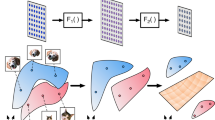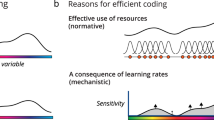Abstract
To achieve near-zero training error in a classification problem, the layers of a feed-forward network have to disentangle the manifolds of data points with different labels to facilitate the discrimination. However, excessive class separation can lead to overfitting because good generalization requires learning invariant features, which involve some level of entanglement. We report on numerical experiments showing how the optimization dynamics finds representations that balance these opposing tendencies with a non-monotonic trend. After a fast segregation phase, a slower rearrangement (conserved across datasets and architectures) increases the class entanglement. The training error at the inversion is stable under subsampling and across network initializations and optimizers, which characterizes it as a property solely of the data structure and (very weakly) of the architecture. The inversion is the manifestation of tradeoffs elicited by well-defined and maximally stable elements of the training set called ‘stragglers’, which are particularly influential for generalization.
This is a preview of subscription content, access via your institution
Access options
Access Nature and 54 other Nature Portfolio journals
Get Nature+, our best-value online-access subscription
$29.99 / 30 days
cancel any time
Subscribe to this journal
Receive 12 digital issues and online access to articles
$119.00 per year
only $9.92 per issue
Buy this article
- Purchase on Springer Link
- Instant access to full article PDF
Prices may be subject to local taxes which are calculated during checkout



Similar content being viewed by others
Code availability
The code produced and used in the current study59 is available on GitHub under GNU General Public License v.3 (GPL-3.0) at https://github.com/marco-gherardi/stragglers.
References
Pacelli, R. et al. A statistical mechanics framework for Bayesian deep neural networks beyond the infinite-width limit. Nat. Mach. Intell. https://doi.org/10.1038/s42256-023-00767-6 (2023).
Wakhloo, A. J., Sussman, T. J. & Chung, S. Linear classification of neural manifolds with correlated variability. Phys. Rev. Lett. 131, 027301 (2023).
Cagnetta, F., Petrini, L., Tomasini, U. M., Favero, A. & Wyart, M. How deep neural networks learn compositional data: the random hierarchy model. Preprint at arXiv https://doi.org/10.48550/arXiv.2307.02129 (2023).
Feng, Y., Zhang, W. & Tu, Y. Activity–weight duality in feed-forward neural networks reveals two co-determinants for generalization. Nat. Mach. Intell. 5, 908–918 (2023).
Baldassi, C. et al. Learning through atypical phase transitions in overparameterized neural networks. Phys. Rev. E 106, 014116 (2022).
Ingrosso, A. & Goldt, S. Data-driven emergence of convolutional structure in neural networks. Proc. Natl Acad. Sci. USA 119, e2201854119 (2022).
Advani, M. S., Saxe, A. M. & Sompolinsky, H. High-dimensional dynamics of generalization error in neural networks. Neural Netw. 132, 428–446 (2020).
Goldt, S., Mézard, M., Krzakala, F. & Zdeborová, L. Modeling the influence of data structure on learning in neural networks: the hidden manifold model. Phys. Rev. X 10, 041044 (2020).
Mézard, M. Mean-field message-passing equations in the hopfield model and its generalizations. Phys. Rev. E 95, 022117 (2017).
Neyshabur, B., Bhojanapalli, S., McAllester, D. & Srebro, N. Exploring generalization in deep learning. In Proc. 31st International Conference on Neural Information Processing Systems (eds von Luxburg, U. et al.) 5949–5958 (Curran Associates, 2017).
Zhang, C., Bengio, S., Hardt, M., Recht, B. & Vinyals, O. Understanding deep learning requires rethinking generalization. Preprint at arXiv https://doi.org/10.48550/arXiv.1611.03530 (2016).
Martin, C. H. & Mahoney, M. W. Rethinking generalization requires revisiting old ideas: statistical mechanics approaches and complex learning behavior. Preprint at arXiv https://doi.org/10.48550/arXiv.1710.09553 (2017).
Khosla, P. et al. Supervised contrastive learning. In Advances in Neural Information Processing Systems 34: Annual Conference on Neural Information Processing Systems 2020 (eds Larochelle, H. et al.) 18661–18673 (Curran Associates, 2020); https://proceedings.neurips.cc/paper/2020/file/d89a66c7c80a29b1bdbab0f2a1a94af8-Paper.pdf
Kamnitsas, K. et al. Semi-supervised learning via compact latent space clustering. In Proc. 35th International Conference on Machine Learning (eds Dy, J. & Krause, A.) 2459–2468 (PMLR, 2018); https://proceedings.mlr.press/v80/kamnitsas18a.html
Hoffer, E. & Ailon, N. in Similarity-Based Pattern Recognition (eds Feragen, A. et al.) 84–92 (Springer, 2015).
Salakhutdinov, R. & Hinton, G. Learning a nonlinear embedding by preserving class neighbourhood structure. In Proc. 11th International Conference on Artificial Intelligence and Statistics (eds Meila, M. & Shen, X.) 412–419 (PMLR, 2007); https://proceedings.mlr.press/v2/salakhutdinov07a.html
Chopra, S., Hadsell, R. & LeCun, Y. Learning a similarity metric discriminatively, with application to face verification. In Proc. 2005 IEEE Computer Society Conference on Computer Vision and Pattern Recognition (eds Schmid, C. et al.) 539–546 (IEEE, 2005).
Schilling, A., Maier, A., Gerum, R., Metzner, C. & Krauss, P. Quantifying the separability of data classes in neural networks. Neural Netw. 139, 278–293 (2021).
Chung, S., Lee, D. D. & Sompolinsky, H. Classification and geometry of general perceptual manifolds. Phys. Rev. X 8, 031003 (2018).
Russo, A. A. et al. Motor cortex embeds muscle-like commands in an untangled population response. Neuron 97, 953–966 (2018).
Kadmon, J. & Sompolinsky, H. Optimal architectures in a solvable model of deep networks. In Advances in Neural Information Processing Systems 29: Annual Conference on Neural Information Processing Systems 2016 (eds Lee, D. et al.) 4781–4789 (Curran Associates, 2016); https://proceedings.neurips.cc/paper/2016/file/0fe473396242072e84af286632d3f0ff-Paper.pdf
Pagan, M., Urban, L. S., Wohl, M. P. & Rust, N. C. Signals in inferotemporal and perirhinal cortex suggest an untangling of visual target information. Nat. Neurosci. 16, 1132–1139 (2013).
DiCarlo, J. J. & Cox, D. D. Untangling invariant object recognition. Trends Cogn. Sci. 11, 333–341 (2007).
Farrell, M., Recanatesi, S., Moore, T., Lajoie, G. & Shea-Brown, E. Gradient-based learning drives robust representations in recurrent neural networks by balancing compression and expansion. Nat. Mach. Intell. 4, 564–573 (2022).
Cohen, U., Chung, S., Lee, D. D. & Sompolinsky, H. Separability and geometry of object manifolds in deep neural networks. Nature Commun. 11, 746 (2020).
Ansuini, A., Laio, A., Macke, J. & Zoccolan, D. Intrinsic dimension of data representations in deep neural networks. In Advances in Neural Information Processing Systems 32: Annual Conference on Neural Information Processing Systems 2019 (eds Wallach, H. et al.) 6109–6119 (Curran Associates, 2020); https://proceedings.neurips.cc/paper_files/paper/2019/file/cfcce0621b49c983991ead4c3d4d3b6b-Paper.pdf
Farrell, M., Recanatesi, S., Lajoie, G. & Shea-Brown, E. Recurrent neural networks learn robust representations by dynamically balancing compression and expansion. Poster presented at Real Neurons & Hidden Units: Future Directions at the Intersection of Neuroscience and Artificial Intelligence @ NeurIPS 2019 (2019); https://openreview.net/forum?id=BylmV7tI8S
Recanatesi, S. et al. Dimensionality compression and expansion in deep neural networks. Preprint at arXiv https://doi.org/10.48550/arXiv.1906.00443 (2019).
Poole, B., Lahiri, S., Raghu, M., Sohl-Dickstein, J. & Ganguli, S. Exponential expressivity in deep neural networks through transient chaos. In Advances in Neural Information Processing Systems 29: Annual Conference on Neural Information Processing Systems 2016 (eds Lee, D. et al.) 3360–3368 (Curran Associates, 2016); https://proceedings.neurips.cc/paper/2016/file/148510031349642de5ca0c544f31b2ef-Paper.pdf
Frosst, N., Papernot, N. & Hinton, G. Analyzing and improving representations with the soft nearest neighbor loss. In Proc. 36th International Conference on Machine Learning (eds Chaudhuri, K. & Salakhutdinov, R.) 2012–2020 (PMLR, 2019); https://proceedings.mlr.press/v97/frosst19a.html
Achille, A., Paolini, G. & Soatto, S. Where is the information in a deep neural network? Preprint at arXiv https://doi.org/10.48550/arXiv.1905.12213 (2019).
Achille, A. & Soatto, S. Emergence of invariance and disentanglement in deep representations. J. Mach. Learn. Res. 19, 1947–1980 (2018).
Shwartz-Ziv, R. & Tishby, N. Opening the black box of deep neural networks via information. Preprint at arXiv https://doi.org/10.48550/arXiv.1703.00810 (2017).
Bengio, Y. in Statistical Language and Speech Processing (eds Dediu, A.-H. et al.) 1–37 (Springer, 2013).
Zdeborová, L. Understanding deep learning is also a job for physicists. Nat. Phys. 16, 602–604 (2020).
Gherardi, M. Solvable model for the linear separability of structured data. Entropy 23, 305 (2021).
Mézard, M. Spin glass theory and its new challenge: structured disorder. Indian J. Phys. https://doi.org/10.1007/s12648-023-03029-8 (2023).
Rotondo, P., Lagomarsino, M. C. & Gherardi, M. Counting the learnable functions of geometrically structured data. Phys. Rev. Res. 2, 023169 (2020).
Belkin, M., Hsu, D., Ma, S. & Mandal, S. Reconciling modern machine-learning practice and the classical bias–variance trade-off. Proc. Natl Acad. Sci. USA 116, 15849–15854 (2019).
Nakkiran, P. et al. Deep double descent: where bigger models and more data hurt. J. Stat. Mech. 2021, 124003 (2021).
Arpit, D. et al. A closer look at memorization in deep networks. In Proc. 34th International Conference on Machine Learning (eds Precup, D. & Teh, Y. W.) 233–242 (PMLR, 2017).
Saxe, A. M., Mcclelland, J. L. & Ganguli, S. Exact solutions to the nonlinear dynamics of learning in deep linear neural network. Preprint at arXiv https://doi.org/10.48550/arXiv.1312.6120 (2014).
Erba, V., Gherardi, M. & Rotondo, P. Intrinsic dimension estimation for locally undersampled data. Sci. Rep. 9, 17133 (2019).
Facco, E., d’Errico, M., Rodriguez, A. & Laio, A. Estimating the intrinsic dimension of datasets by a minimal neighborhood information. Sci. Rep. 7, 12140 (2017).
Li, C., Farkhoor, H., Liu, R. & Yosinski, J. Measuring the intrinsic dimension of objective landscapes. Preprint at arXiv https://doi.org/10.48550/arXiv.1804.08838 (2018).
Rotondo, P., Pastore, M. & Gherardi, M. Beyond the storage capacity: data-driven satisfiability transition. Phys. Rev. Lett. 125, 120601 (2020).
Pastore, M., Rotondo, P., Erba, V. & Gherardi, M. Statistical learning theory of structured data. Phys. Rev. E 102, 032119 (2020).
Gherardi, M. & Rotondo, P. Measuring logic complexity can guide pattern discovery in empirical systems. Complexity 21, 397–408 (2016).
Geiger, M., Spigler, S., Jacot, A. & Wyart, M. Disentangling feature and lazy training in deep neural networks. J. Stat. Mech. 2020, 113301 (2020).
Mazzolini, A., Gherardi, M., Caselle, M., Cosentino Lagomarsino, M. & Osella, M. Statistics of shared components in complex component systems. Phys. Rev. X 8, 021023 (2018).
Mazzolini, A. et al. Zipf and heaps laws from dependency structures in component systems. Phys. Rev. E 98, 012315 (2018).
Sorscher, B., Geirhos, R., Shekhar, S., Ganguli, S. & Morcos, A. Beyond neural scaling laws: beating power law scaling via data pruning. Adv. Neural Inf. Process. Syst. 35, 19523–19536 (2022).
Bengio, Y., Louradour, J., Collobert, R. & Weston, J. Curriculum learning. In Proc. 26th Annual International Conference on Machine Learning (eds. Bottou, L. & Littman, M.) 41–48 (ACM, 2009).
LeCun, Y. & Cortes, C. MNIST handwritten digit database (2010); http://yann.lecun.com/exdb/mnist/
Clanuwat, T. et al. Deep learning for classical Japanese literature. Preprint at arXiv https://doi.org/10.20676/00000341 (2018).
Xiao, H., Rasul, K. & Vollgraf, R. Fashion-MNIST: a novel image dataset for benchmarking machine learning algorithms Preprint at arXiv https://doi.org/10.48550/arXiv.1708.07747 (2017).
Krizhevsky, A. & Hinton, G. Learning Multiple Layers of Features from Tiny Images. Tech. Rep. 0 (Univ. of Toronto, 2009).
Cardy, J. Finite-Size Scaling (North-Holland, 1988).
Gherardi, M. Inversion dynamics of class manifolds in deep learning reveals tradeoffs underlying generalisation. Zenodo https://doi.org/10.5281/zenodo.8355859 (2023).
Acknowledgements
P.R. acknowledges funding from the Fellini programme under the H2020-MSCA-COFUND action, grant no. 754496, INFN (IT).
Author information
Authors and Affiliations
Contributions
S.C. and M.G. discovered the stragglers. M.G., M.O. and P.R. conceived and designed the experiments. L.C., S.C., M.G. and F.V. performed the experiments. All authors analysed the results and wrote the paper. M.G. and M.O. supervised the analysis. M.G. coordinated the project.
Corresponding author
Ethics declarations
Competing interests
The authors declare no competing interests.
Peer review
Peer review information
Nature Machine Intelligence thanks Christopher Kanan and the other, anonymous, reviewer(s) for their contribution to the peer review of this work.
Additional information
Publisher’s note Springer Nature remains neutral with regard to jurisdictional claims in published maps and institutional affiliations.
Supplementary information
Supplementary Information
Supplementary Figs. 1–6.
Rights and permissions
Springer Nature or its licensor (e.g. a society or other partner) holds exclusive rights to this article under a publishing agreement with the author(s) or other rightsholder(s); author self-archiving of the accepted manuscript version of this article is solely governed by the terms of such publishing agreement and applicable law.
About this article
Cite this article
Ciceri, S., Cassani, L., Osella, M. et al. Inversion dynamics of class manifolds in deep learning reveals tradeoffs underlying generalization. Nat Mach Intell 6, 40–47 (2024). https://doi.org/10.1038/s42256-023-00772-9
Received:
Accepted:
Published:
Issue Date:
DOI: https://doi.org/10.1038/s42256-023-00772-9



